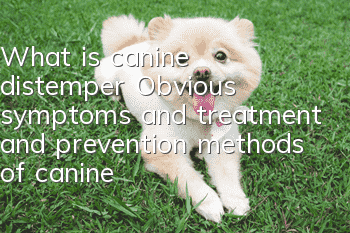What is canine distemper? Obvious symptoms and treatment and prevention methods of canine distemper

Canine distemper (CD) is a highly contagious and fatal infectious disease caused by canine distemper virus. Sick dogs present with biphasic fever, acute catarrhal inflammation of the respiratory tract and digestive tract, and muscle symptoms in the mid-to-late stages. Characterized by convulsions or paralysis. The fatality rate is high, and the fatality rate for puppies can reach more than 80%.
【Pathogens and Epidemiology】
1. Pathogens and transmission routes
Canine distemper virus, family Paramyxoviridae, genus Morbillivirus, single-stranded RNA virus.
It is mainly transmitted through the respiratory tract and digestive tract, but can also be infected through the conjunctiva, oral mucosa and nasal mucosa.
2. Source of infection: Mainly infected dogs and virus-carrying dogs.
3. Susceptible animals: Canids, mustelids and raccoons, dogs of all ages, genders and breeds can be infected, but dogs between 3 and 12 months old Puppies are the most susceptible and often develop the disease in whole litters. Dogs that recover from the disease can acquire antibodies for a long time or even for life.
4. Popularity:It has obvious varieties, ages and seasonality. Purebred dogs are prone to the disease, dogs weaned to less than 1 year old are prone to the disease, and the number increases significantly in late autumn and early summer.
【Symptoms】
1. Biphasic elevated body temperature:
The incubation period of this disease is 3 to 6 days. The body temperature rises to 39.8~41℃, which lasts for 1~2 days, followed by a remission period of 2~3 days (the body temperature tends to 38.9~39.2). As the body temperature rises again, symptoms of respiratory and digestive system infections become apparent, and even nervous system infections become apparent.
2. Respiratory symptoms:
The main symptoms of this disease: At the beginning of the disease, dogs are slightly depressed, have loss of appetite, shed tears, have watery nasal fluid, and occasionally cough or artificially induced cough is positive. Afterwards, the secretions from the eyes and nose turn to mucus or purulence, and the breath sounds are rough on auscultation of the larynx, trachea and lungs. In the middle and later stages of the disease, bronchopneumonia often develops. The nose of the affected dog is dry (cracked) and there is a large amount of pus nasal fluid.
Most of the dogs suffer from the unique appearance of purulent conjunctivitis: purulent eye gums adhere to the inner and outer canthus and upper and lower eyelids, and the canthus and eyelid periphery are hairless and bald, as if they are wearing a pair of glasses.
3. Digestive system symptoms:
Initial and middle stage of illnessThere are often vomiting symptoms during this period, but the frequency is not large, and there is loss of appetite or loss of appetite, which has certain symptomatic significance for the disease. Puppies usually pass dark brown loose stools mixed with mucus or blood, while adult dogs usually have no stool for several days. The affected dog gradually became dehydrated and collapsed due to vomiting, diarrhea and loss of appetite.
4. Nervous system symptoms:
Neurological symptoms mostly appear in the middle and late stages of the disease, and a few appear at the beginning of the disease, which is of great significance in indicating the disease. In mild cases, the lips, eyelids, and ears twitch; in severe cases, stepping, turning or rolling, movement ataxia, paralysis of the hind limbs, and repeated rhythmic twitching of the masseter muscles or limbs when lying on the side are the characteristic manifestations of this disease.
5. Skin and foot pad symptoms:
In the early or late stages of the disease, some affected dogs have excessive keratinization and hardening of the foot pads of their limbs. Young dogs often have rice- or bean-sized erythema, blisters or pustules in thin skin areas under the abdomen and medial thighs. After antibiotic treatment, the purulent rash on the lower abdomen and medial thigh quickly dried up and disappeared. The hardened cuticle of the foot pads of recovering dogs gradually peels off.
【Diagnosis】
Imported canine distemper rapid diagnostic test strips take the eyes, nasal secretions, saliva or urine of affected dogs as test samples, and diagnosis can be made within 5 to 10 minutes. Other methods will not be introduced in detail.
【Treatment】
Inject canine distemper monoclonal antibody or anti-canine distemper hyperimmune serum as soon as possible at the beginning of the disease. The dose should generally be greater than 1~2ml/kg body weight, and should be used for 2~3 days. In order to inhibit viral proliferation and control secondary bacterial infections, ribavirin, Shuanghuanglian, Qingkailing, ampicillin, cephalosporin V or ceftriaxone are often used. For dogs with fever, use diazepam or compound aminopyrine, together with hydrocortisone or dexamethasone. If you have symptoms of hematochezia, you can use Anluoxue or Hemostasis Sensitivity.
Early infusion and combined application of canine interferon, cytokines and other immune enhancers can effectively prevent the body from dehydration, improve disease resistance, and promote the recovery of sick dogs
【Prognosis】
When dogs are initially sick and have not yet shown typical symptoms, injecting canine distemper monoclonal antibodies or high-dose hyperimmune serum as soon as possible can enhance the immune status enough to prevent the development of the disease. If characteristic clinical symptoms, especially neurological symptoms, appear, the prognosis is poor. Even if the dog survives patient treatment, it often leaves sequelae of twitching limbs or unconsciousness.
Currently, commonly used sera include monoclonal antibodies, potent canine distemper serum, triple serum (canine distemper, parvovirus, infectious laryngotracheitis), and pentalytic serum (canine distemper, parvovirus, infectious hepatitis, parainfluenza, and coronavirus). ), six-linked serum (canine distemper, parvovirus, infectious hepatitis, parainfluenza, coronavirus and rabies)
【Prevention】
At present, domestically produced canine five-, six- or seven-combination vaccines can be used to prevent canine distemper and other common diseases.
Five combinations (rabies, canine distemper, parvovirus, infectious hepatitis, parainfluenza), six combinations plus coronavirus, and seven combinations plus pseudorabies virus.
The recommended vaccination schedule is: puppies should be vaccinated starting when they are 7 to 9 weeks old, and then vaccinated 2 to 3 times at intervals of 2 to 3 weeks, and then boosted once every six months. Dogs over 3 months old can be injected twice. In order to prevent the puppies from contracting infectious diseases, the female dog can be given an extra dose about 45 days after breeding.
- golden retriever pregnancy process
- What should I do if my dog doesn’t eat the new dog food?
- How to train an aggressive dog? Train a very aggressive dog!
- What should I do if my dog has dystocia? A must-read for emergency measures for dog dystocia!
- What are the symptoms of canine distemper in dogs? The early symptoms of canine distemper!
- Symptoms and treatment methods of epilepsy in dogs
- Do dog owners need to be vaccinated?
- The Origin and History of the Australian Cattle Dog
- Simple methods and precautions for making homemade dog food
- What training method should you choose to train your dog? How to get good results



